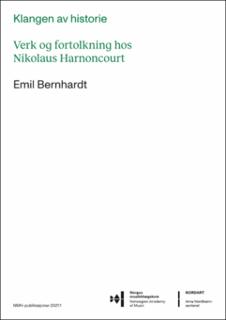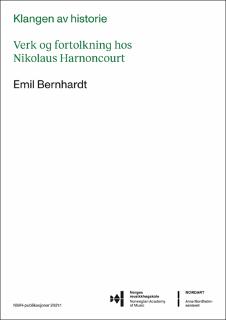| dc.contributor.author | Bernhardt, Emil | |
| dc.date.accessioned | 2021-01-19T08:58:22Z | |
| dc.date.available | 2021-01-19T08:58:22Z | |
| dc.date.issued | 2021 | |
| dc.identifier.isbn | 978-82-7853-290-4 (trykt) | |
| dc.identifier.isbn | 978-82-7853-291-1 (pdf) | |
| dc.identifier.issn | 0333-3760 | |
| dc.identifier.issn | 2535-373X (online) | |
| dc.identifier.uri | https://hdl.handle.net/11250/2723587 | |
| dc.description | Avhandling (Ph.D.) - Norges musikkhøgskole, Oslo 2021 - Dissertation for the PhD degree Norwegian Academy of Music, Oslo 2021 | en_US |
| dc.description.abstract | Sammendrag
Den østerrikske dirigenten Nikolaus Harnoncourt (1929–2016) og hans fortolkningspraksis i vid forstand utgjør sentrum i denne studien. Tilnærmingen er ikke primært biografisk, verkanalytisk eller historisk, snarere estetisk, kritisk og filosofisk. Målet er å diskutere og utvikle begreper (dels hentet fra Harnoncourts egne tekster, dels fra et bredere teoretisk vokabular) som spesifikt vil være i stand til å åpne og gjøre synlig sentrale aspekter ved Harnoncourts fortolknings- og fremføringspraksis, og som mer generelt kan være egnet til å utvikle forskning på musikalsk fortolkning, særlig knyttet til fremføring av orkestermusikk.
Et grunnleggende premiss er at Harnoncourts musikalske praksis springer ut av det som er blitt hetende historisk informert fremføringspraksis (HIP). Studien hevder at den historiske orienteringen som kjennetegner denne tendensen, tilfører musikalsk fortolkningspraksis et diskursivt element. Med dette menes dels et arbeid med historisk kunnskap og informasjon – oftest begrepslig artikulert, og gjerne akademisk forankret –, dels en refleksjon over hvordan informasjonen og kunnskapen får prege de konkrete musikalske fremføringene. Studiens grunnleggende spørsmål retter seg mot forholdet mellom historisk bevissthet og musikalsk suksess; mellom begrepslig orientering og praktisk-musikalsk fortolkning; mellom diskursivitet og estetisk erfaring.
Studien hevder at det som kjennetegner Harnoncourt som musikalsk fortolker er hvordan han lykkes med å omfunksjonere det diskursive elementet til å bli et relevant aspekt i sine fremføringer, forstått som gjenstander for min estetiske erfaring. Diskursiviteten blir følgelig ikke bare et element i det forberedende arbeidet med verkene, snarere strekker den seg som en akse helt inn i det aktuelle fremføringsøyeblikket og videre inn i lyttingen. Hvordan dette mer konkret foregår blir diskutert dels gjennom tre eksempler – Symfoni nr. 39 i Ess-dur av W. A. Mozart, første sats; Symfoni nr. 5 i c-moll av L. v. Beethoven, andre sats; og Symfoni nr. 8 (store C-dur) av F. Schubert, andre sats –, dels gjennom en inngående undersøkelse av forholdet mellom utøverintensjon og lyttererfaring. Hva gjelder Harnoncourts eget arbeid vil særlig begrepene «historie», «språk» og «transparens» stå sentralt, mens begrepene om performativitet og estetisk erfaring vil spille en vesentlig rolle i utviklingen av lytterperspektivet. | en_US |
| dc.description.abstract | English summary
This study focuses on the performance practice of the Austrian conductor, Nikolaus Harnoncourt (1929–2016). The approach is aesthetical and philosophical rather thanbiographical and historical. The study aims at discussing and developing concepts (partly taken from Harnoncourt’s own texts, partly from a broader theoretical vocabulary) that may reveal and make visible central aspects of Harnoncourt’s specific interpretation and performance practice. It also seeks to contribute to a more general conceptual development in current research on musical interpretation, especially with regard to orchestral music.
A basic premise of the study is that Harnoncourt’s performance practice has its roots in what has been called the historically informed/oriented performance practice (HIP). The study argues that the historical orientation that characterizes this movement adds a discursive element to the practice of musical interpretation. By ‘discursive element’ I mean partly an occupation with historical knowledge and information (which is usually articulated in academic terms), partly a reflection on how this information may be seen to influence the concrete musical performance. The basic inquiry of the study is directed towards the relationship between historical consciousness and musical success; between conceptual orientation and practical interpretation; between theoretical discourse and aesthetic experience.
The study argues that the main characteristic of Harnoncourt as a conductor is how he manages to turn the discursive element into an imminent aspect of his performances, regarded as objects of my aesthetic experience. In other words, the role of discourse and discursivity is not merely limited to the preparatory work ahead of the actual realisation. Rather, it forms an axis that reaches into the very moment of musical performance and of musical listening. How this happens is discussed partly through the analysis of three examples – his performances of Symphony No. 39 in E flat major by W. A. Mozart, first movement; of Symphony No. 5 in c minor by L. v. Beethoven, second movement; and of Symphony No. 8 (The Great C major) by F. Schubert, second movement – and partly through a thorough investigation of the relationship between musical performance and the listening experience. Regarding Harnoncourt’s own work, the concepts of history, language and transparency will be of central importance, whereas the concepts of performativity and aesthetic experience will be crucial when it comes to the listener’s perspective. | en_US |
| dc.language.iso | nob | en_US |
| dc.publisher | Norges musikkhøgskole | en_US |
| dc.relation.ispartofseries | NMH-publikasjoner;2021:1 | |
| dc.subject | Harnoncourt | en_US |
| dc.subject | dirigent | en_US |
| dc.subject | musikalsk fortolkning | en_US |
| dc.subject | orkesterverk | en_US |
| dc.subject | historisk fremføringspraksis | en_US |
| dc.title | Klangen av historie. Verk og fortolkning hos Nikolaus Harnoncourt | en_US |
| dc.type | Doctoral thesis | en_US |
| dc.description.version | publishedVersion | en_US |
| dc.subject.nsi | VDP::Humaniora: 000::Musikkvitenskap: 110::Musikkhistorie: 111 | en_US |
| dc.source.pagenumber | ix, 248 s. | en_US |

